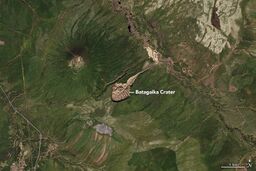Earth:Batagaika crater
| Batagaika crater | |
|---|---|
 Batagaika crater, 2016. NASA photo | |
| Lua error in Module:Location_map at line 408: Malformed coordinates value. | |
| Coordinates | Template:Coord/display/i |
| Geology | Depression |
The Batagaika crater is a thermokarst depression in the Chersky Range area.[1] The biggest permafrost crater in the world,[2] it administratively belongs to the Sakha Republic, Russia ,[1] and is in its Verkhoyansky District.
Description
The depression is in the form of a one-kilometre-long gash up to 100 metres (328 feet) deep, and growing, in the East Siberian taiga, located 10 km (6.2 mi) southeast of Batagay and 5 km (3.1 mi) northeast of the settlement Ese-Khayya, about 660 km (410 mi) north-northeast of the capital Yakutsk. The structure is named after the near-flowing Batagayka, a right tributary of the river Yana. The land began to sink due to the thawing permafrost in the 1960s after the surrounding forest was cleared.[3] Flooding also contributed to the enlargement of the crater. Paleontologists have found Ice Age fossils buried in the mud around the rim of the crater.[3] The rim is extremely unstable as there are regular landslides into the crater and the permafrost is constantly thawing. The crater is currently growing in size.[3][4][5][6]
According to Mary Edwards of the University of Southampton, the process of erosion that increases the crater's size occurs in the following way:[4]
Below the cliff face, steep hills and gullies drop to Batagaika's floor. As more of the material at the bottom of the slope melts and comes loose, a larger face is exposed to the air, which in turn increases the speed of permafrost thawing. The crater will likely eat through the entire hillslope before it slows down. Every year as soon as temperatures go above freezing, it's going to start happening again. Once you've exposed something like this, it's very hard to stop it.
According to a conference paper published in 2016[7] the crater did not show any signs of stabilization after several decades (since 1980s) of slump growth, with the headwall retreating with observed rates of generally >10 m and up to 30m per year closer to 2016. Reconstruction of a paleo-surface revealed that the slump had carved at the time into the rolling topography to a depth of up to 73 m. The current size of the slump was then >69 ha, and it had thawed >25 × 106 m³ of ice-rich permafrost through 2016.
Fossils and relation to climate
The rapid expansion of the crater is uncovering a host of fossilized materials, including ancient forests and pollen and animal carcasses such as that of musk ox, mammoth and horse, along with other animals.[1][5] It also allows for insight into 200,000 to 650,000 years of climate data.[8][9]
Drone footage[6][10] revealed in 2023 more details of the crater, and Nikita Tananayev, lead researcher at the Melnikov Permafrost Institute in Yakutsk interviewed by Reuters for the occasion,[11] warned that the expansion of the Batagaika crater is a sign of danger: with increasing temperatures and anthropogenic pressure more and more of similar mega-slumps are likely to be formed in the future, and also the soil beneath the slump, which is about 100 metres deep (328 feet) in some areas, contains organic carbon stores that will release into the atmosphere as the permafrost thaws, further fuelling the planet's warming.
References
- ↑ 1.0 1.1 1.2 "200,000 year old soil found at mysterious crater, a 'gate to the subterranean world'". The Siberian Times. http://siberiantimes.com/science/casestudy/news/n0678-200000-year-old-soil-found-at-mysterious-crater-a-gate-to-the-subterranean-world/.
- ↑ "Batagaika Crater Expands" (in en). 2017-04-27. https://earthobservatory.nasa.gov/images/90104/batagaika-crater-expands.
- ↑ 3.0 3.1 3.2 "Siberia's 'Doorway To The Underworld' Is Rapidly Growing In Size". Forbes. February 28, 2017. https://www.forbes.com/sites/trevornace/2017/02/28/siberias-doorway-underworld-rapidly-growing-size/#4b18902e6599.
- ↑ 4.0 4.1 Batagaika Crater Expands, NASA Earth Observatory, April 27, 2017
- ↑ 5.0 5.1 MacDonald, Fiona. "There's a 'Doorway to The Underworld' in Siberia So Big It's Uncovered Ancient Forests" (in en-gb). https://www.sciencealert.com/siberian-doorway-to-the-underworld-so-huge-millennia-old-forests-and-carcasses-climate-change.
- ↑ 6.0 6.1 MacDonald, Fiona. "A Drone Flew Into Siberia's 'Doorway to The Underworld' And The Footage Is Epic" (in en-gb). https://www.sciencealert.com/a-drone-flew-into-siberias-doorway-to-the-underworld-and-the-footage-is-epic.
- ↑ Günther, F.; Grosse, G.; Jones, B. M.; Schirrmeister, L.; Romanovsky, V. E.; Kunitsky, V. V. (12–16 December 2016). "Unprecedented permafrost thaw dynamics on a decadal time scale: Batagay mega thaw slump development, Yana Uplands, Yakutia, Russia". San Francisco, USA: AGU Fall Meeting. https://hdl.handle.net/10013/epic.49450.
- ↑ Murton, Julian B.; Edwards, Mary E.; Lozhkin, Anatoly V.; Anderson, Patricia M.; Savvinov, Grigoriy N.; Bakulina, Nadezhda; Bondarenko, Olesya V.; Cherepanova, Marina V. et al. (March 2007). "Preliminary paleoenvironmental analysis of permafrost deposits at Batagaika megaslump, Yana Uplands, northeast Siberia" (in en). Quaternary Research 87 (2): 314–330. doi:10.1017/qua.2016.15. ISSN 0033-5894.
- ↑ Murton, J., Opel, T., Toms, P., Blinov, A., Fuchs, M., Wood, J., Gärtner, A., Merchel, S., Rugel, G., Savvinov, G., Wetterich, S. (2021). A multimethod dating study of ancient permafrost, Batagay megaslump, east Siberia. Quaternary Research, 1-22. doi:10.1017/qua.2021.27.
- ↑ The world's biggest permafrost crater is growing. YouTube. Reuters. Jul 21, 2023. Retrieved 2023-07-30.
- ↑ "World's biggest permafrost crater in Russia’s Far East thaws as planet warms" (in en-gb). https://www.reuters.com/business/environment/worlds-biggest-permafrost-crater-russias-far-east-thaws-planet-warms-2023-07-21/.
External links
- Batagaika Crater Expands at NASA Earth Observatory, 27 April 2017.
- Siberia's growing hole in the ground, BBC Reel (video, 4:48 min.), 27 July 2020.
 |

